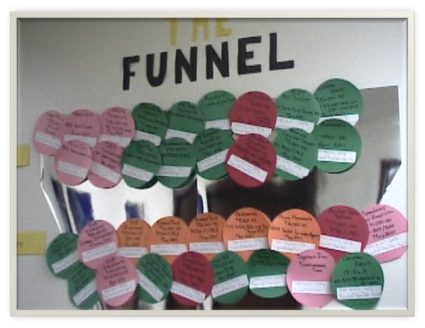Focus on the top of the funnel and everything else will work out. This seems to dominate so much of the conversation I see. It’s not wrong, but it’s not completely right.
But this thinking drives our focus on MQLs, SQLs and massive prospecting efforts.
We seem to overlook the questions, “How do we know what ‘Top of Funnel’ we need? How do we shift that in our favor?”
We cannot focus exclusively on Top of Funnel. What drives our Top of Funnel requirements is what happens in the funnel itself. What’s our win rate, what’s our average deal size, what’s the sales cycle, what’s the quality of the opportunities we are managing in the qualified funnel?
These variables determine our top of funnel needs.
As a very simple example, if everything else is constant (revenue goals, sales cycle, average deal, deal quality), an organization with a 20% win rate and another with a 50% win rate, have very different top of funnel needs. The first requires a 5X healthy pipeline, the latter requires a 2X pipeline.
Let’s do a thought experiment with this as an example.
Let’s imagine to make the same revenue, with similar sales cycles, average deal size, each organization needs to close 50 deals to achieve the same goals. The company with a 50% win rate needs 100 deals in their pipeline. The company with a 20% win rate needs 250 deals in their pipeline.
Let’s say, for both organizations they qualify 1 out of every 10 opportunities they prospect. As a result, the 50% win rate needs to be prospecting 1000 opportunities to keep the pipeline filled. The company with the 20% win rate will have to prospect 2500 opportunities to keep the pipeline filled.
The focus on the the top of funnel, will cause managers to focus on “Are you doing the right prospecting to find those number of opportunities (whether it is 1000 or 2500)?”
But when we focus just on that, on doing the right amount of prospecting to keep the pipeline filled, we focus only on the things that enable us do that prospecting. And that’s what the top of the funnel focus drives. It would never cause people to think about, “What if we changed our win rate? What if we changed our deal size? What if we changed our sales cycle? All of these are variables that are controlled in the funnel, not by the top of the funnel. But these changes have a dramatic impact on the top of the funnel metrics.
So if our 20% win rate company could somehow manage to get a 50% win rate, their top of funnel metrics change profoundly.
But let’s go further. Again, making the assumption that all every thing is equal, they need to prospect 2500 opportunities, qualifying 250, to win 100 takes far more time than the company with the 50% win rate. And each has to do this in the year. So the costs they incur to do all that work are much higher–as a result, profitability will be adversely impacted. In the 20% win rate case, we have to provide the resources and support to focus, simultaneously on developing 2500 opportunities, moving them 250 of them into the funnel and winning 100. It’s significantly more resource than the 50% win rate company needs to do to close 100 deals and produce the same revenue.
But it gets worse. There’s a flawed assumption I made in the analysis above. The 20% win rate company sucks at selling and closing qualified deals. They are just bad at it, particularly when compared to the 50% win rate company. But the flawed assumption I made is they are both equal in ability in prospecting. They each get the same results from their prospecting, they have similar skills and each can find high quality opportunities from 1 of every 10 prospects.
But is that a reasonable assumption? If they are so bad at closing qualified deals, will they be as good as the higher win rate company in their prospecting. Common sense tells us absolutely not. The 20% close rate company will probably have to prospect many more opportunities, to find and qualify 250 high quality opportunities. Or the quality of opportunity they qualify is worse, which adversely impacts win rates–making things even worse.
I’ll stop here, you can see where I’m going with this discussion. As much as we’d like to say, “If I just concentrate on the top of the funnel, all our problems are solved,” we cannot view things in isolation. We have to look at the end to end process and the interactions throughout the process. Once we understand the dynamics of this end to end process, we can begin to understand the leverage points in driving performance.
And these leverage points are never static. For example, in the 50% win rate organization, I still want to look at how I drive performance. Can we improve win rate? Can we improve average deal size, can we reduce sales cycles, can we improve the yield from our prospecting?
I hate to get too nerdy, but we have to use systems thinking in everything we do in analyzing and driving performance. We have to look at the whole system, the interrelationships between the components of the system, and where we have leverage in driving performance.

Leave a Reply